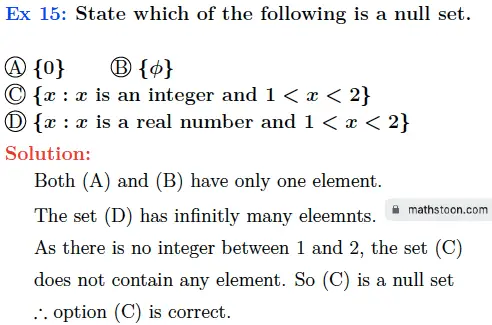SN Dey Class 11 Solutions | SN Dey Class 11 Set Theory Solutions | Class 11 Set Theory MCQ | SN Dey Solutions | S N Dey Math Solutions | Set Theory S N Dey Solutions | WBCHSE Class 11 Math Solutions | Set theory objective questions
SN Dey Class 11 Set Theory MCQ Solutions
Choose the correct option:
Ex 1: The number of subsets in a set consisting of four distinct elements is-
(A) 4 (B) 8 (C) 16 (D) 64
Answer:
We know that the number of subsets in a set consisting of n distinct elements is equal to 2n.
So the answer is
= 24 = 16.
∴ option (C) is correct.
Ex 2: The number of proper subsets in a set consisting of five distinct elements is-
(A) 5 (B) 10 (C) 32 (D) 31
Answer:
We know that the number of proper subsets in a set consisting of n distinct elements is equal to 2n-1.
So the answer is
= 25-1= 32-1 = 31.
∴ option (D) is correct.
Ex 3: If x ∈ A ⇒ x ∈ B then –
(A) A=B (B) A⊂B (C) A⊆B (D) B⊆A
Answer:
As x ∈ A ⇒ x ∈ B, then we must have that either A is a proper subset of B or they are equal. So the answer is A ⊆ B.
∴ option (C) is correct.
Ex 4: If A⊆B and B⊆A then –
(A) A=Φ (B) A∩B=Φ (C) A=B (D) None of these
Answer:
As A⊆B and B⊆A, then it follows that A=B.
So option (C) is correct.
Ex 5: For two sets A and B, if A∪B = A∩B then –
(A) A⊆B (B) B⊆A (C) A=B (D) None of these
Answer:
Let then
As
⇒
…..(i)
Similarly, if then, =
⇒
Thus, we get that B…..(ii)
So from (i) and (ii), we obtain that
∴ option (C) is correct.
Ex 6: A – B = Φ iff – [Council Sample Question ’13]
(A) A≠B (B) A⊂B (C) B⊂A (D) A∩B=Φ
Answer:
We know that A-B ={x: x ∈ A but x ∉B}. Thus A-B=Φ means that A is fully contained in B, that is, A⊂B.
∴ option (B) is correct.
Ex 7: If A∩B = B then –
(A) A⊆B (B) B⊆A (C) A=B (D) A=Φ
Answer:
As B=A∩B, we have B ⊆ A∩B.
⇒ B ⊆ A and B ⊆ B.
⇒ B ⊆ A is true.
∴ option (B) is correct.
Ex 8: If A and B are two disjoint sets then n(A∪B)=
(A) n(A)+n(B) (B) n(A)-n(B) (C) 0 (D) None of these
Answer:
As A and B are disjoint sets, so we have A∩B = Φ. Thus n(A∩B)=0.
Now, we know that
n(A∪B) = n(A)+n(B)-n(A∩B)
= n(A)+n(B)+0
= n(A)+n(B)
∴ option (A) is correct.
Ex 9: For any two sets A and B, n(A)+n(B)-n(A∩B)=
(A) n(A∪B) (B) n(A)-n(B) (C) Φ (D) None of these
Answer:
As n(A∪B) = n(A)+n(B)+n(A∩B), the option (A) is correct.
Ex 10: The dual of A∪U = U is-
(A) A∪U=U (B) A∪Φ=Φ (C) A∪Φ=A (D) A∩Φ=Φ
Answer:
The dual of A∪U = U is A∩Φ=Φ.
∴ option (D) is correct.
Ex 14: State which of the is the set of factors of the number 12-
(A) {2, 3, 4, 6} (B) {2, 3, 4, 6, 12}
(C) {2, 3, 4, 8, 6} (D) {1, 2, 3, 4, 6, 12}
Answer:
The factors of 12 are 1, 2, 3, 4, 6, and 12.
∴ option (D) is correct.

This article is written by Dr. T, an expert in Mathematics (PhD). On Mathstoon.com you will find Maths from very basic level to advanced level. Thanks for visiting.